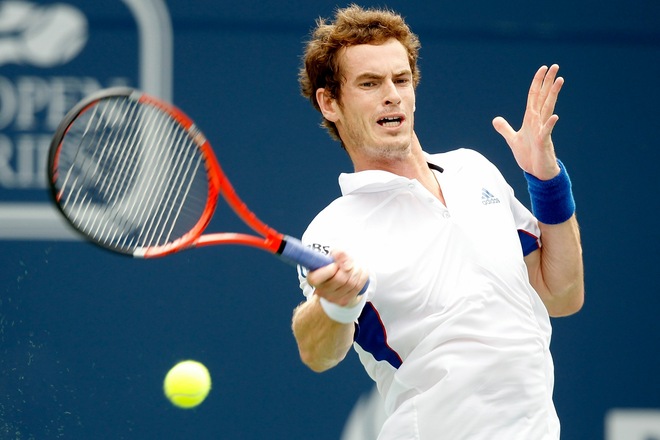By Charles Bricker
There must have been about 5,000 Andy Murray fans in the stands and half of Scotland back home ready to boil him in oil for that impetuous, and failed, drop shot attempt on match point Sunday.
But, what was that the Bard said about things that end well? Two points later, as Andy got back down to business and Roger Federer’s drive from the baseline sailed well long, the British No. 1 was home with his second straight Rogers Cup title and his fifth ATP 1000 shield.
Crazy drop shots aside, this was the new, redefined Andy Murray out there and maybe, just maybe he has finally been convinced that he can’t reach the mountaintop in this game unless he comes out of his counter-punching shell and starts walloping winners.
That’s what he has done the last two days in dunking world No. 1 Rafael Nadal 6-3, 6-4 and now No. 3 Federer by 7-5, 7-5. I don’t know how many pieces I’ve written over the last three years about Murray’s overly-defensive tactics.

He’s a great defender because of his speed, his ability to redirect the ball on the run and his amazing consistency from the backcourt, and I’ve never had a quibble with Murray about playing that kind of tennis through the early rounds of an ATP 1000 or a Grand Slam.
But once he reaches the semis and in some cases the quarters, you’ve got to do more because the elite players in this game are capable of trading safe shots point-for-point with him.
On another day, Murray would come out of a match like this final with 13 winners and 10 unforced errors — something along that line. He had 24 and 24 in this match, and those increased unforced errors are not a worry because when you commit to playing more offensively you’re going to have more misses.
The point is that Murray has also increased his winners against the top players and by playing more aggressively, he forces changes in the games of his opponents.
Federer, now 29, had some golden moments in this rain-delayed match, but he was never consistently as good as Murray and he may have been feeling some fatigue after having long matches and close calls against both Tomas Berdych in the quarters and No. 2 Novak Djokovic in the semis.
This match came to a head (yes, I know Murray uses a Head racket) on the first match point, when Federer returned a backhand crosscourt not deep but sharply angled. Murray was on it and, with one of the best down-the-line backhands in the game, that was his shot. Instead, in one of those incomprehensible Murray Moments, he tried to brush a backhand dropper. It never cleared the net.
He immediately won his serve to earn a second match point and this time he went to the power and induced Federer into a forced error to end it.
Murray was No. 4 coming into this match and won’t go higher because, having won Rogers Cup a year ago, he is only treading water with the 1,000 points he earned. But he is, suddenly and hopefully, a new player and that cold foretell great things the rest of 2010.
He has 11 losses to go with 30 wins this season, but, though he’s been in a few finals, he had not won that one blockbuster until he whipped Federer on Sunday.
This one is a blockbuster. It lasted two hours and four minutes, not counting umbrella time, and Murray now has his 15th overall title. He was broken only once by Federer, and in the second set, Murray won 18 of his 20 first-serve points — a major key. But not quite as major as Murray’s recognition, at last, that he can’t just play ping-pong out there.
Will he carry these tactics over to Cincinnati this week? We’ll see. He doesn’t have to be super-aggressive in the early rounds because his defensive and counter-punching skills are good enough to get him through the first few days. But he has to recognize the point at which he has to turn on the juice.
If he does that at Cincinnati, backing up what he did at Toronto, he’s suddenly the lead favorite at the U.S. Open.
Charles Bricker can be reached at nflwriterr@aol.com
